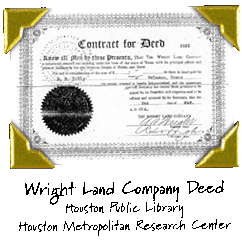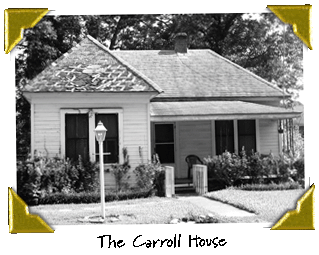

Home
| Contents | Next
Housing in Independence Heights
|
What
made this settlement different from other black neighborhoods
in Houston was the possibility of personal land ownership.
In 1905, A.A. Wright, a white real estate businessman
from the north, moved to Houston and purchased property
north of Houston.
Within five years, he had established two businesses,
the Wright Loan and Security and the Wright Land Company.
The first was a company which was formed to sell land
to whites, and the second was a company created to sell
land to blacks.
|
|
|
___Mr.
Wright owned the land that would later become Independence
Heights. Unlike many of his contemporaries, he was willing
to sell land to African Americans and also to sell the
land at lower than average interest rates. Not surprisingly,
many enterprising African American families were drawn
to the opportunity to purchase property where they could
build the house of their dreams on their own plot of land.
_____“You
see that’s why they bought out here, so they could build
the kind of houses that they wanted, ‘cause the houses
for rent [in Houston] were shotguns,” explained Mrs. Vivian
Seals, the resident historian of Independence Heights.
|
| _____Many
homes were built with such skill and thought that they are
still standing today. The variety and styles of homes are
amazing. Each one is its own creation, carefully planned
by its owner. |
| _____The
majority of the neighborhood’s houses were built by resident
contractors and craftsman such as W.H. Chryar, Archie and
Richard Thompson, Reverend J.S. Beverly, and Stephen Mitchell.
Mike Jefferson and Tom Patten were electricians; James and
Leroy Bland were bricklayers. Mrs. Vivian Seals recollects,
“Just about everything we needed for a city was here.” Many
residents would work in Houston during the weekdays and
then return home to work on building homes for their own
community during the evenings and weekends |
 |
 |
_____The
citizens of Independence Heights not only bought their own
land, but they also built their own houses, maintained a
flourishing business economy, and created a city that existed
for fourteen years, as a separate city, from 1915 until
annexation in 1929. |
 |
_____Residents
had hoped that annexation to the city of Houston in 1929
would mean that more city services would become available.
However, most of Houston’s black neighborhoods, and many
other such neighborhoods in the South, had insufficient
city services. In 1940, only about 23 percent of black-occupied
homes had running water, while 95 percent of non-black
homes had water service. In addition, black neighborhoods
were often in need of paved streets, street lights, and
adequate drainage.
|
Home
| Contents | Back to Top
Next
|
 |